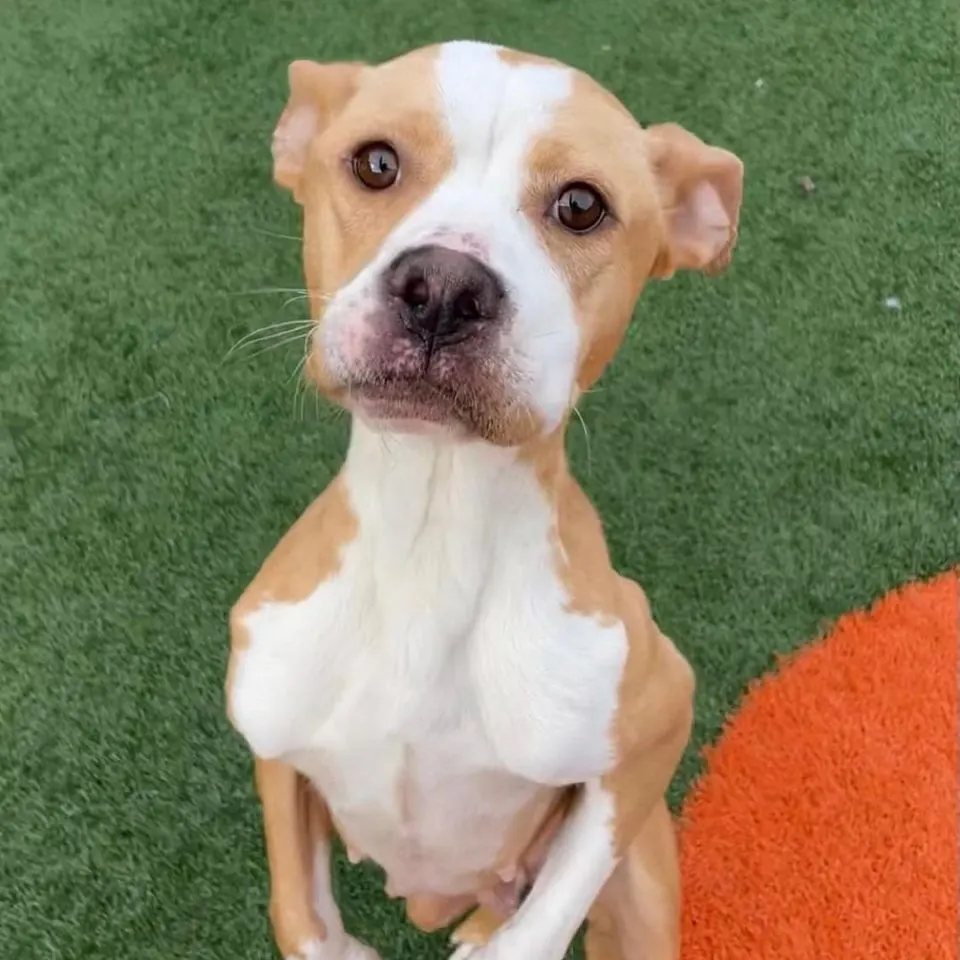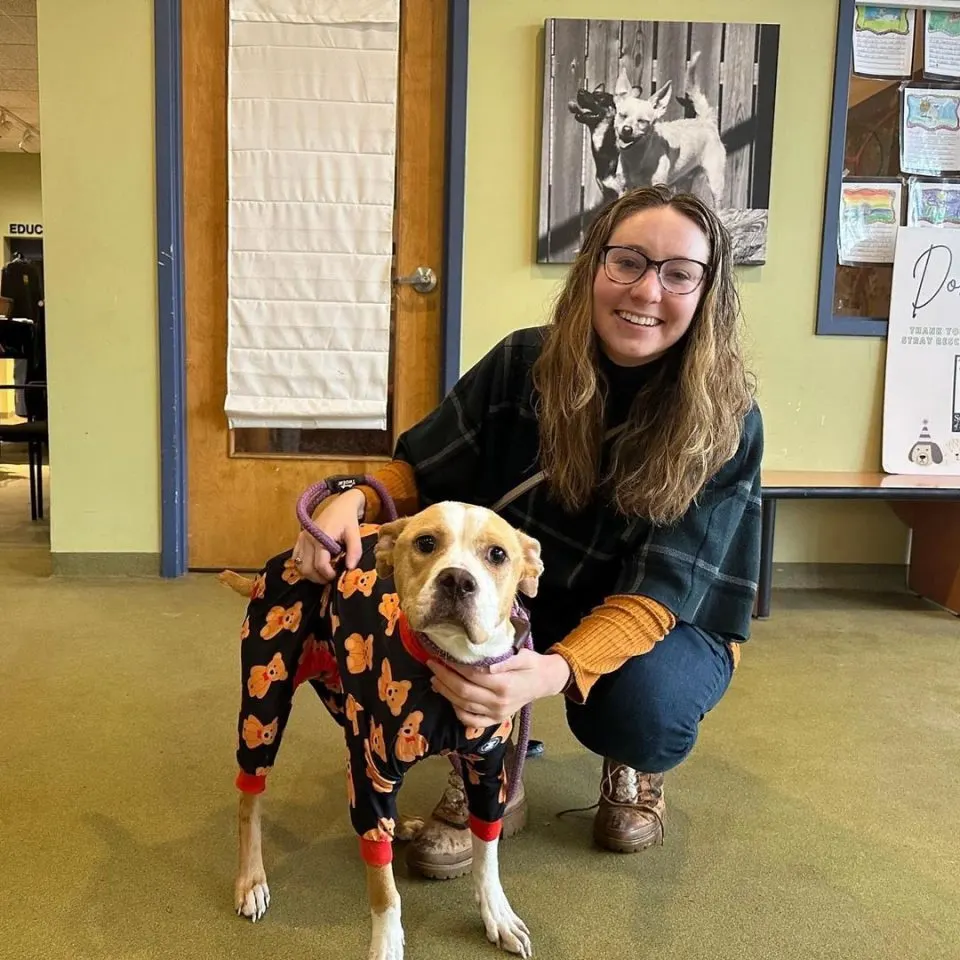It was a casual morning for Donna Lochmann, with a new rescue task on her schedule – a part of the job with a lot of dangers behind the corners – but one that she worked with her full heart and passion.
“A dog awaits and needs our help!” said this experienced Stray Rescue of St. Louis rescuer after an emergency call for medical intervention.
Her coworker, Natalie Thompson, immediately jumped into the passenger seat with the same passion and pride that another puppy would be saved.
Little did they know that a much bigger journey awaited them on the streets of St.Louis.
An Unexpected Change Of Plans
While Donna was speeding up so that they could get to their destination on time, Natalie suddenly jerked and shouted at Donna to slow down.

“I just saw something small and brown hanging out on a side street,” said Donna to a surprised Natalie. “It might be another dog that needs our help” she continued.
Indeed, that was a puppy and Natalie confirmed it. But, as she later stated in one interview, reason still prevailed, though deciding it was wiser to go back and look for him after their primary mission.
The medical intervention was quick and successful, and everything was perfectly ready for the start of another rescue mission.
A Blanket Full Of Emotions
When they came to the “place of crime”, they immediately got out of the car to find their dog, but unfortunately, there was no sign of him.
“I was so devastated at that one moment” Natalie admitted later. But, as an experienced rescuer, her senses were sharp, and she started looking in an alleyway. And, BOOM, there she was. A scared, skinny dog that was rushing in an unknown direction.
At that moment, Natalie lost sight of the dog but immediately noticed her at the end of the alleyway, where she entered an abandoned multi-floor building.

Natalie later admitted that it was one of the scariest places she had ever visited, but that just pumped up her motivation to rescue this poor puppy because no one deserves to be in a place like this.
Once she entered the building, she immediately noticed the stairs. They were really unstable, but what kind of person would she be if she hadn’t taken the chance?
Once she finally got to the second floor, her eyes were immediately filled with tears due to what she had witnessed. A little, skinny puppy in a blanket trying to get some warmth from the rough, cold place in which she was living.

A Proud Moment For Every Dog Rescuer
After this hard moment, Natalie didn’t wait for one more second and immediately reached for her slip lead, but quickly realized she didn’t have it.
“I only had one slip lead with me, and it was on the dog in the Jeep,” Lochmann said.
When she came back from the Jeep with her most dependable rescue tool, her puppy wasn’t there. Fortunately, Natalie noticed another door on the second floor and she realized that the dog had gone out through that door.
And, yes – after breaking through the outskirts of the building, she found her sitting in an open field. She didn’t want to scare her, and she also didn’t know her personality.

But, hey – what could possibly go wrong if you offered some food to the dog? Vienna sausages did the trick and she immediately gained the pup’s trust.
Natalie named this little sweetie “Dodie” because she had such a cute doll face.
After that, it was really easy to put a leash around the dog and get her into the Jeep.
“In general, this is one of the hardest parts of the whole mission because some dogs are really afraid, but Dodie is truly one of a kind,” said Natalie.
Providing Her With The Life That She Really Deserves
After the successful rescue mission, the two brave rescuers brought her to the vet and, as expected for this amazing girl, she went through the test without a single moan. Way to go, girl!
Even her health was surprisingly good. The only problem was the fact that she was underweight.
Because of that, she was on a strict feeding schedule, with a very small portion several times throughout the day.
Up to this day, Dodie is safe in a foster home, wrapped in a truly warm and fuzzy blanket, with the addition of true love from her foster mom, Nicolina, along with other loving people and volunteers from this amazing foster home.

If you’ve noticed your furry friend’s paws looking a bit redder than usual, it might raise some concerns. Your dog’s paws are their foundation, allowing them to explore the world around them with boundless energy. The sight of redness can be a signal that something is amiss and may require your attention. As a seasoned dog enthusiast, you understand the importance of keeping your canine companion’s paws in top-notch condition for their overall well-being.
Your dog’s paws are their trusty companions on walks, runs, and adventures by your side. Redness in their paw pads could indicate various underlying issues that need to be addressed promptly. As a responsible pet parent, being attuned to changes in your dog’s paws is crucial for maintaining their comfort and health. Let’s take a closer look at what might be causing this redness and how you can help your loyal companion bounce back to their playful self.
Understanding the Red Paws Phenomenon
Signs and Symptoms to Watch For
If you’re wondering why your furry friend’s paws are red, there are some key signs and symptoms to keep an eye out for. Check for redness, swelling, or irritation on the paw pads. Your dog might start licking or chewing their paws excessively, indicating discomfort. Observing limping or reluctance to walk can also be signs of red paws needing attention.
Common Causes of Red Paws in Dogs
Red paws in dogs can stem from various common causes. One prevalent reason is allergies, including contact allergies from irritants like grass or chemicals. Food allergies can also manifest as redness in the paws. Additionally, infections, such as fungal or bacterial ones, can lead to red and inflamed paw pads. Another factor to consider is environmental factors like hot pavements or rough terrains that may cause irritation. Regular paw checks and prompt action can help alleviate your dog’s red paw issues.
Contact Allergies and Irritants
Identifying and Removing Environmental Triggers
You can identify environmental triggers that may be causing your dog’s red paws by observing their behavior. Look for patterns like redness after walks on specific surfaces or coming into contact with certain substances. This can help you pinpoint and eliminate potential irritants. Consider using protective paw wax or booties to shield their paws from allergens.
Treatment Options for Allergies
If your dog is suffering from contact allergies, it’s essential to consult your veterinarian for proper diagnosis and treatment. They may recommend topical ointments, oral medications, or hypoallergenic diets to alleviate symptoms. Bathing your dog with a gentle, hypoallergenic shampoo can also help remove allergens from their fur and paws. Regular vet visits and proactive management are key to keeping your furry friend’s paws healthy and redness-free.
Infections and Infestations
Bacterial and Fungal Infections
Bacterial and fungal infections can cause redness in your dog’s paws. These infections are often accompanied by other symptoms like odor, discharge, or changes in paw texture. If you notice these signs, it’s essential to consult your vet for proper diagnosis and treatment. Treatment may involve topical ointments, oral medications, or foot soaks to eliminate the infection.
Parasites That Cause Redness and Itching
Parasites such as ticks, fleas, or mites can lead to redness and itching in your dog’s paw pads. Regular preventative measures like flea and tick treatments can help reduce the risk of infestation. If you suspect parasites are causing your dog’s paw issues, seek advice from your vet. They may recommend specific treatments to rid your dog of parasites and alleviate paw discomfort.
Remember, prompt identification and management of infections and infestations are crucial for maintaining your dog’s paw health. If you notice any unusual signs in your dog’s paws, it’s best to seek professional guidance to ensure prompt and effective treatment.
Food Allergies and Sensitivities
How Diet Can Affect Your Dog’s Paws
Your dog’s diet plays a significant role in their overall health, including their paw condition. Certain food allergies can manifest as redness or irritation on the paws. Dogs can be allergic to common ingredients like beef, chicken, wheat, or soy, leading to skin issues, including paw problems. Monitoring your dog’s diet and consulting with your vet can help identify and address potential food-related sensitivities that may be affecting their paw health.
Elimination Diets and Nutritional Management
If you suspect that your dog’s paw redness is due to a food allergy, your vet may recommend an elimination diet. This process involves removing potential allergens from your dog’s diet and gradually reintroducing them to pinpoint the specific trigger. Switching to hypoallergenic or novel protein diets can also be beneficial in managing food sensitivities that impact your dog’s paws. Proper nutritional management tailored to your dog’s needs can help alleviate paw issues caused by dietary factors. Regular communication with your vet is crucial for implementing a suitable diet plan to support your dog’s paw health.
Injuries and Physical Stressors
Signs of Paw Injuries
If your dog’s paws are red, it could signal an injury. Watch out for signs like cuts, scrapes, or foreign objects stuck in the paw pads. Look for bleeding, swelling, or tenderness when you touch their paws. Excessive licking, limping, or your dog’s reluctance to walk may also indicate paw issues. Keeping an eye on these signs can help you identify and address paw injuries promptly.
Preventive Measures and Care
To prevent paw injuries and keep your dog’s paws healthy, consider protective measures like using paw wax or booties when walking on rough surfaces. Regularly trim your dog’s nails to prevent painful overgrowth. Ensure your pup’s environment is safe, free of sharp objects or chemicals that could harm their paws. Providing a balanced diet with essential nutrients can also improve paw health. Regular vet check-ups and proactive care are key to maintaining your dog’s overall paw well-being.
When to See a Vet
Home Remedies vs. Professional Medical Advice
If your dog’s paw is red, swollen, or displaying signs of discomfort, it’s crucial to distinguish when to opt for home remedies and when to seek professional medical advice. Minor issues like mild redness from temporary irritation can often be managed at home with gentle cleaning and monitoring. However, if the redness persists, worsens, or is accompanied by other concerning symptoms like excessive licking or limping, it’s time to consult a vet.
What to Expect During the Vet Visit
During a vet visit for your dog’s red paws, the veterinarian will conduct a thorough examination to determine the underlying cause of the issue. Be prepared to discuss your dog’s symptoms, any changes in behavior, recent activities, and preventive measures you’ve taken. The vet may recommend diagnostic tests, such as skin scrapings or allergy testing, to pinpoint the exact reason for the redness. Treatment options, which may include medication, topical ointments, or dietary adjustments, will be tailored to address your dog’s specific paw health needs.
Preventive Care and Maintenance
Routine Paw Care Tips
To keep your dog’s paws healthy, start by regularly checking them for any signs of redness, swelling, or cuts. You can gently wipe their paws with a damp cloth after walks to remove any dirt or debris that could cause irritation. Trimming your dog’s nails is also essential to prevent them from becoming overgrown and affecting your dog’s gait. If you’re unsure about nail trimming, consider seeking guidance from a professional groomer or vet.
Protective Gear and Products to Consider
Consider using protective gear like paw wax or booties when taking your dog out for walks, especially in extreme weather conditions. Paw wax can help create a barrier between your dog’s paws and harsh surfaces, while booties can protect them from hot pavement or cold snow. Additionally, using dog-friendly moisturizers can help keep your dog’s paw pads hydrated and prevent them from drying out and cracking. Remember to introduce new products gradually to ensure your dog doesn’t have any adverse reactions.
Conclusion
Keeping an eye on your furry friend’s paws is key to their overall well-being. If you notice redness, swelling, or other concerning signs, it’s essential to take action promptly. Whether it’s allergies, infections, or injuries causing the red paws, being proactive in addressing these issues is crucial. Remember, a vet visit can provide the necessary insight and treatment tailored to your dog’s specific needs. By staying attentive and implementing preventive measures like paw wax and regular nail trimming, you can help your pup maintain healthy paws. Prioritizing your dog’s paw health through proper care and timely interventions will ensure they stay happy and active for years to come.
Frequently Asked Questions
What are common signs of paw issues in dogs?
Signs of paw issues in dogs include redness, swelling, excessive licking, limping, or reluctance to walk.
What are some common causes of paw problems in dogs?
Common causes of paw problems in dogs include allergies, infections, injuries, and food allergies.
How can I prevent paw injuries in my dog?
You can prevent paw injuries in your dog by using protective measures like paw wax or booties, along with regular nail trimming.
When should I seek professional advice for my dog’s paw issues?
Seek professional advice if redness persists or worsens, or if your dog shows severe signs of discomfort or pain.
What should I expect during a vet visit for my dog’s red paws?
During a vet visit for red paws, expect a thorough examination, discussion about symptoms, activities, and potential diagnostic tests for proper diagnosis and treatment.
[no_toc]

Hey there, I’m Janet Brooks, a dog-loving student from California. I’m all about helping pups in need, especially those without homes. Me and my awesome friends work together to give shelter and love to stray dogs. Oh, and I also write blogs about dogs to share helpful info.